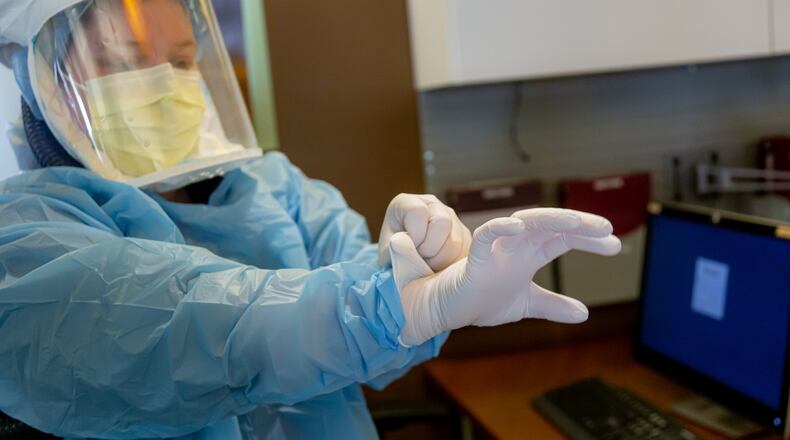Since Monday, Dec. 7, the state has reported a total of 87,703 new cases. The number was magnified somewhat as Ohio began reporting positive COVID-19 antigen tests on Tuesday without additional verification, resulting in more than 25,000 cases added on Tuesday. Previously, the Ohio Department of Health verified the cases before adding them to the case total. The Ohio Hospital Association reported that 5,152 people are currently hospitalized with COVID-19.
Ohio surpassed the milestone of 7,000 deaths from coronavirus on Monday as the state reported 63 new deaths. Over 9,200 cases were reported Monday, which Gov. Mike DeWine announced was the sixth highest case number since the beginning of the pandemic. According to ODH, the state passed 6,000 deaths on Nov. 23, meaning that over 1,000 deaths were reported within the span of about two weeks.
The CDC in August changed its case definition to allow antigen tests to be included in case counts without additional verification. The ODH continued to manually verify those exposures and symptoms before counting these tests as positive, DeWine said.
On Tuesday, ODH added 12,600 positive antigen tests to the case total, which pushed Ohio over half a million positive coronavirus tests. The tests date back to Nov. 1, DeWine said.
“After understanding more about antigen tests, the Centers for Disease Control and Prevention, changed their case definition in August allowing antigen tests to be included in case counts without additional verification,” said ODH Chief Medical Officer Dr. Bruce Vanderhoff. “ODH is now aligned with CDC’s current definition and we will begin reflecting those tests immediately in our daily reported case counts moving forward.”
On Nov. 28, Ohio surpassed 400,000 total cases after reporting more than 6,800 daily cases. The state has recorded another 100,000 cases in less than two weeks.
Hospitalizations increased by 657 Tuesday, for a total of 30,226. Just under 5,200 people were in hospitals across Ohio, with 1,226 in southwest Ohio. On Tuesday, over 200 people were on ventilators and 273 people were in intensive care units in southwest Ohio.
More than 10,000 daily cases of coronavirus were reported in Ohio Wednesday, bringing the total to 520,112, according to the Ohio Department of Health.
The state was averaging 9,585 daily cases a day. As cases have continued to climb, so has the state’s positivity rate. On Monday, Ohio’s daily positivity rate was 18.5%, its highest since the end of April, according to ODH. The seven-day average was 16.1% on Wednesday.
Deaths increased by 84 on Wednesday, bringing the total to 7,187.
On Thursday, DeWine extended the 10 p.m. curfew to Jan. 2. He initially announced the curfew would last from Nov. 19 to Dec. 10, but he extended it as cases continue to rise.
“We believe this will help reduce COVID-19 spread,” he said. “I’m also asking each Ohioan every day to do at least one thing that reduces your contact with others.”
The curfew does not apply people going to and from work, anyone getting groceries or picking up takeout, going to the hospital or picking up medicine, DeWine said.
“The goal is to have fewer contacts,” he said. “The whole idea is if you can slow these contacts down it will go a long way in slowing this virus down.”
Violation of the curfew would be a second-degree misdemeanor, DeWine said.
“It really goes back to what the doctors tells and that is that this virus is spread by contact,” he said. “If you can you reduce contact you are statistically going to the reduce spread of the virus. So if you can cut down on the time of people out mingling you are going to knock it down.”
DeWine said the curfew would not impact religious services, so midnight mass would not be affected.
The next three weeks are crucial in Ohio’s fight against coronavirus, DeWine said, noting that our actions over the next 21 days will set the tone for next year.
“These next several weeks will be the toughest yet,” he said. “We’re heading into the biggest holiday season on our calendar, while riding the biggest wave of COVID-19 that we’ve had so far.”
Ohio cannot afford to overwhelm hospitals and health care workers right before the state is expected to start receiving its first batches of the coronavirus vaccination, DeWine said.
“COVID-19 is the single greatest threat to the physical wellbeing of all Ohioans, the mental health of our citizens, and our economic security,” he said.
Deaths across the US topped more than 3,000 people in one day, the Associated Press reported. The death toll for Tuesday topped D-Day and 9/11 as the deadliest day during the coronavirus pandemic.
The crisis across the country is pushing medical centers to the breaking point and leaving staff members and public health officials burned out and plagued by tears and nightmares.
All told, the crisis has left more than 290,000 people dead nationwide, with more than 15.5 million confirmed infections.
The U.S. recorded 3,124 deaths Wednesday, the highest one-day total yet, according to Johns Hopkins University. Up until last week, the peak was 2,603 deaths on April 15, when New York City was the epicenter of the nation’s outbreak. The latest number is subject to revision up or down, the Associated Press reported.
In St. Louis, respiratory therapist Joe Kowalczyk said he has seen entire floors of his hospital fill up with COVID-19 patients, some of them two to a room. He said the supply of ventilators is dwindling, and the inventory is so thin that colleagues on one shift had to ventilate one patient by using a BiPAP machine, similar to the devices used to treat sleep apnea.
When he goes home to sleep during the day at the end of his grueling overnight shifts, he sometimes has nightmares.
“I would be sleeping and I would be working in a unit and things would go completely wrong and I would shock myself awake. They would be very visceral and very vivid,” he said. “It would just really spook me.”
Ohio recorded another 10,000 cases of coronavirus Friday, making it the fourth day in a row to do so, according to the Ohio Department of Health.
The state added 10,359 cases, bringing its total to 542,209.
Ohio dipped below the 400 daily hospitalizations mark Friday for the first time since Monday. The state reported 394 hospitalizations, above the 21-day average of 361.
For the six straight day, Ohio has more than 5,000 COVID-19 patients in hospitals across the state. According to ODH, there are 5,091 coronavirus inpatients Friday, with 1,187 in southwest Ohio.
COVID-19 patients accounted for 16.30% of hospital beds and 21.09% of ICU beds in the region, a slight decrease from the 18% and 27% respectively reported earlier this month.
The state recorded 128 deaths Friday, bringing the total to 7,426.
On Thursday, Gov. Mike DeWine announced that the state’s curfew will continue through Jan. 2.
“We believe the curfew, along with mask-wearing, have had an impact, and the next 21 days are extremely critical,” he said. “We must all do everything we can to slow down the virus.”
Saturday marked the fifth day in a row that Ohio reported more than 10,000 new coronavirus cases. 11,252 new cases were reported Saturday. The state reported 267 new hospitalizations and 51 new deaths.
The 21 day case average passed 10,000, totaling an average of 10,008 cases a day.
With the state expected to receive its first batch of the coronavirus vaccine in the next week, DeWine said it’s important that Ohioans continue to follow health guidelines to avoid overwhelming hospitals before the state can start distributing the vaccine.
“These are steps that are sensible steps that we can all follow and will allow us to still live our lives,” he said, “This is about living with this virus and living with it in a safe way.”
The state reported 9,266 new cases of COVID-19 on Sunday, bringing the state’s total cases to 562,717. Hospitalizations increased by 170 and deaths increased by 15, bringing hospitalizations to 31,973 and deaths to 7,492.
The Ohio Hospital Association reported that 5,152 people are currently hospitalized with COVID-19, meaning one in four patients have tested positive. In southwest Ohio, 1,287 people are currently hospitalized and 157 people are in an intensive care unit.
In Ohio, 1,186 people are in an ICU and 807 people are on ventilators.
The first shipments of a COVID-19 vaccine for widespread use in the United States headed Sunday from Michigan to distribution centers across the country, with the first shots expected to be given in the coming week to health care workers and at nursing homes.
Shipments of the Pfizer vaccine will set in motion the biggest vaccination effort in American history at a critical juncture of the pandemic that has killed 1.6 million and sickened 71 million worldwide.
Initially, about 3 million doses were expected to be sent out, and the priority is health care workers and nursing home residents as infections, hospitalizations and deaths soar in the U.S. With numbers likely to get worse over the holidays, the vaccine is offering a bright spot in the fight against the pandemic that’s killed nearly 300,000 Americans.
About the Author

